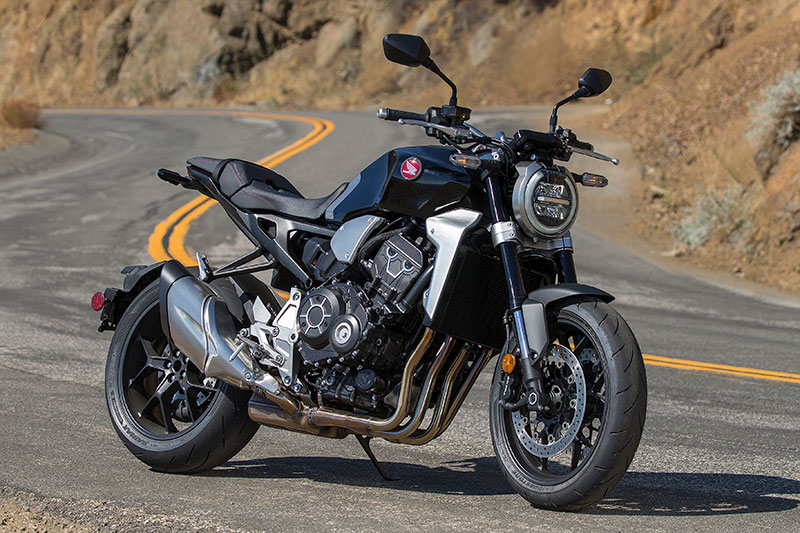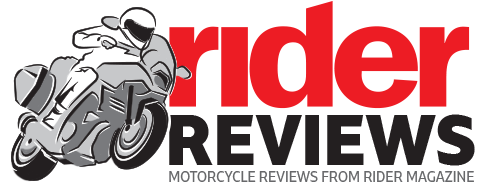2018 Honda CB1000R

First Ride Review
Motorcycles that sell well enough to stay in a manufacturer’s lineup typically get updated every few years. Usually the update is minor—some reshaped bodywork or “bold new graphics,” perhaps a few nips and tucks to the ergonomics and instrumentation, but costly stuff like the engine and chassis is left untouched. Sometimes the update is major—a top-to-bottom overhaul with new styling, new technology and internal changes that reduce weight and deliver more performance. What rarely happens, however, is a complete reinvention. But that’s exactly what Honda has done with the CB1000R.
Developed for the naked bike-mad European market in 2007, the CB1000R combined a detuned version of the 998cc in-line four from the CBR1000RR sportbike with a go-fast chassis, more comfortable ergonomics and futuristic styling with minimal bodywork. Due to the gut punch the U.S. motorcycle market received during the Great Recession, however, the CB1000R didn’t arrive on our shores until the early part of this decade—a time when American motorcycle buyers had little interest in naked bikes. That its styling was quirky and its performance was lackluster relative to the competition made matters worse. The CB1000R ended up like the kid who’s picked last for the kickball team.
But what a difference a few years can make. Now naked bikes are the hot ticket, with sales having more than doubled since 2012 for bikes displacing 900-1,200cc. Not only that, but the average naked bike buyer is 45-55 years old and has two decades of riding experience, and middle-aged folks (like me!) don’t go for bikes that look like they just rolled out of a video game. Café racers, classic standards and retro bikes tug at the heartstrings of bygone youth, but few wax nostalgic about wooden brakes and sacked-out shocks. Honda’s answer is what it calls Neo-Sports Café design, a transformation of the CB1000R from a run-of-the-mill naked sportbike into a modern café racer.
Park a 2016 CB1000R next to a 2018 (the 2017 model year was skipped) and you’d never know they’re so closely related. In place of the previous model’s swoopy bodywork and odd banana-shaped exhaust is a shorter, stockier profile with harder edges and more exposed metal. Instead of a bikini headlight fairing there’s a classic round nacelle housing a modern LED. Available only in black, the contrasting silver on the radiator shroud, headlight nacelle and exhaust as well as the machined edges on the blacked-out engine make the CB1000R look a piece of industrial art.
Meant to be ridden rather than looked at, the CB1000R’s reinvention is more than skin deep. Honda claims increased horsepower and torque from the liquid-cooled, DOHC four-cylinder engine (when we last tested a CB1000R in 2011, it made 112 horsepower and 65.5 lb-ft of torque at the rear wheel) thanks to larger ports and reduced pressure loss in the intake system, more valve lift, a higher compression ratio, forged rather than cast pistons and larger throttle bodies (44mm, up from 36mm), and a 4-percent reduction in the overall gear ratio adds more snap to acceleration. Cutting weight was a priority, too. A new exhaust shaves off 10 pounds, a new steel mono-backbone frame (the previous one was aluminum) is stiffer and 5.5 pounds lighter and new cast aluminum pivot plates on the sides of the frame are smaller and lighter. Curb weight is just 465 pounds, down 17 pounds from the previous model.
As before, the CB1000R has a cast aluminum, single-sided swingarm, which showcases the new 10-spoke rear wheel. The swingarm is shorter and the wheel is wider, with the rear rubber going up from a 180/55-ZR17 to a 190/55-ZR17, but the frame is longer from the headstock to the swingarm pivot, stretching the wheelbase to 57.3 inches (up from 56.9). Revisions to the suspension include a fully adjustable, upside-down, 43mm Showa SFF-BP (Separate Function Fork-Big Piston) with rebound and compression damping in the left leg and preload in the right leg; a lighter spring and revised settings for the rebound- and preload-adjustable Showa shock; and increased travel front and rear (4.7/5.2 inches, up from 4.3/5.0). Returning unchanged are the excellent Tokico binders—a pair of 4-piston radial calipers up front squeezing 310mm discs and a 1-piston rear caliper squeezing a 256mm disc—which tell the rider exactly what’s going on and can scrub off a little or a lot of speed with minimal effort. But now 2-channel ABS is standard, a welcome addition, though hooligans will be disappointed to hear that it can’t be turned off.
From the first time I pressed the starter button until the last time I put down the sidestand at the end of the day, my overall impression of the new CB1000R was one of refinement, the sort of civility and precision that’s been a hallmark of certain Honda motorcycles for decades. Whereas the previous CB1000R’s throttle was overly sensitive to on/off transitions and would sometimes surge when held steady, the new model’s throttle-by-wire never missed a beat. Similar to the new Honda Africa Twin Adventure Sports, the CB1000R offers several riding modes (Sport, Street and Rain) with preset levels of throttle response, engine braking and traction control, and a User mode allows the rider to set any combination of these parameters as well as turn traction control completely off.
Our test route wound its way up and down some of the most challenging roads in the Santa Monica Mountains, including Las Flores, Piuma, Mulholland, Latigo, Decker and Little Sycamore, which follow canyons and ridges above Malibu, California. Having attended countless press launches and photo shoots on these roads meant that I knew what to expect, allowing me to focus more on the bike and less on the unknown. The CB1000R may look like a bare-knuckle brawler, but it has the poise and agility of a ballet dancer. Thanks to its light weight and solid chassis, the CB turns in and transitions from side to side with ease, and its Bridgestone Battlax Hypersport S21 tires provide flytrap grip. Even with aggressive inputs, the CB kept a cool head, rarely getting out of shape. The fork was especially forgiving of back-road punishment, whereas the rear shock would sometimes pogo over sudden dips and rises (setting the preload for my weight and dialing in more rebound damping would probably sort that out).
Part of what contributes to the CB1000R’s refined feel is how smoothly its engine spins up and how silky its 6-speed transmission is, aided by a new assist-and-slipper clutch that reduces lever effort. Regardless of riding mode, power delivery was always linear and predictable, but when I let the revs drop in slow corners there wasn’t enough low-end grunt to rocket launch me toward the exit. When I kept the engine spinning above 7,000 rpm, I was golden.
That naked bikes are popular among middle-aged riders isn’t just about style; it’s also about comfort. Decades of full-time employment, often seated at a desk, has given us love handles and chronic lower back pain. Motorcycles with upright seating positions allow us to have fun and still be able to walk the next day. That’s true of the CB1000R, which requires little forward bend to reach the handlebar and has a fairly flat, reasonably comfortable seat, though the footpegs are fairly high so knee bend may be an issue for some. (Even though the CB’s pegs have feelers that are 2.75 inches long, I only scraped one of them once during a hard flog on really tight roads.) Same goes for the 32.7-inch seat height. Overall I had no issues with discomfort, though some high-pitched vibration in the grips made my hands tingle from time to time.
Reinvention is no easy task. The 2018 Honda CB1000R looks better and performs better, with more distinctive styling, less weight, more power, useful technology like ABS and throttle-by-wire, new instrumentation and other improvements. But it’s missing something. As much as I appreciate refinement and civility, there’s a disconnect between the CB1000R’s artful, radical looks and what it feels like. What’s lacking is the mojo that transforms a motorcycle from a machine into a delivery vehicle for emotion. A little more bark from the exhaust, a little more grunt at low rpm, and I’d probably like riding it as much as I enjoy looking at it.
